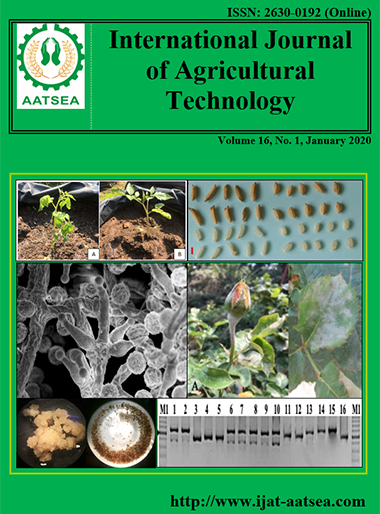Investigation of rice blast resistant genes in Thai elite rice varieties (Oryza sativa L.) for improvement of broad-spectrum blast disease resistance variety
Main Article Content
Abstract
The broad-spectrum blast disease resistance rice Huai variety (GS19567) has been reported to contain more than one blast resistance genes which one of them was mapped on chromosome 11. The blast resistance genes was investigated using gene specific primers in Huai and other 40 Thai elite rice varieties. The results obtained from polymerase chain reaction revealed that all tested varieties contained at least one blast resistant gene. The most frequent finding resistant gene was Pib, while Pib was missing in Huai variety. Therefore, in order to enhance broad spectrum blast disease resistance in a sustaining blast resistance variety, the resistance gene Pib is recommened to be used as candidate gene in breeding program.
Article Details

This work is licensed under a Creative Commons Attribution-NonCommercial-NoDerivatives 4.0 International License.
References
Cho, Y. C., Kwon, S. J., Choi, I. S., Lee, S. K., Jeon, J. S., Oh, M. K., Roh, J. H., Hwang, H. G., Yang, S. J. and Kim, Y. G. (2007). Identification of major blast resistance genes in Korean rice varieties (Oryza sativa L.) using molecular markers. Journal Crop Science Biotechnology, 10:265-276.
Choudhury, B., Khan, M. L. and Dayanandan, S. (2013). Genetic structure and diversity of indigenous rice varieties (Oryza sativa) in Eastern Himalayan region of Northeast India. Springer Plus, 2:228-237.
Dean, R. A., Talbot, N. J., Ebbole, D. J., Farman, M. L., Mitchell, T. K., Orbach, M. J., Thon, M., Kulkarni, R., Xu, J. R., Pan, H., Read N. D., Lee, Y. H., Carbone, I., Brown, D., Oh, Y. Y., Donofrio, N., Jeong, J. S., Soanes, D. M., Djonovic, S., Kolomiets, E., Rehmeyer, C., Li, W., Harding, M., Kim, S., Lebrun, M. H., Bohnert, H., Coughlan, S., Butler, J., Calvo, S., Ma, L. J., Nicol, R., Purcell, S., Nusbaum, C., Galagan, J. E. and Birren, B. W. (2005). The genome sequence of the rice blast fungus Magnaporthe grisea. Nature, 434:980-986.
Deng, Y., Zhu, X., Shen, Y. and He, Z. (2006). Genetic characterization and fine mapping of the blast resistance locus Pigm(t) tightly linked to Pi2 and Pi9 in a broad-spectrum resistant Chinese variety. Theoretical and Applied Genetics, 113:705-713.
Huang, H., Huang, L., Feng, G., Wang, S., Wang, Y., Liu, J., Jiang, N., Yan, W., Xu, L., Sun, P., Li, Z., Pan, S., Liu, X., Xiao, Y., Liu, E., Dai, L. and Wang, G. L. (2011). Molecular mapping of the new blast resistance genes Pi47 and Pi48 in the durably resistant local rice cultivar Xiangzi 3150. Phytopathology, 101:620-626.
Jaihom, N. (2015). Diversity assessment of rice blast fungus (Pyricularia Grisea) collected in Thailand. (Master thesis). King Mongkut's Institute of Technology Ladkrabang, Thailand.
Jia, Y., Wang, Z. and Singh, P. (2002). Development of dominant rice blast Pi-ta resistance gene markers. Crop Science, 42:2145-2149.
Kinoshita, T. (1998). Linkage mapping using mutant genes in rice. Rice Genetics Newsletter, 15:13-74.
Liu, G., Lu, G., Zeng, L. and Wang, G. L. (2002). Two broad-spectrum blast resistance genes, Pi9(t) and Pi2(t), are physically linked on rice chromosome 6. Molecular Genetics and Genomics, 267:472-480.
Mahender, A., Swain, D. M., Gitishree, D., Subudhi, H. N. and Rao, G. J. N. (2012). Molecular analysis of native Manipur rice accessions for resistance against blast. African Journal of Biotechnology, 11:1321-1329.
Parinthawong, N., Tansian, P., Sreewongchai, T., Salih, A. and Sripichitt, P. (2015). Genetic mapping of leaf blast resistance gene in landrace rice cultivar “GS19769”. Maejo International Journal of Science and Technology, 9:278-287.
Phaitreejit, K., Srikaew, E., Jantasuriyarat, C., Sriwongchai, T. and Katengam, S. (2011). Screening Thai landrace rice for blast resistance gene Pi9, Pi36, Pigm(t) using DNA markers. Thai Journal of Genetics, 4:52-62.
Poonsin, R., Parinthawong, N. (2017). Investigation on rice blast disease resistance in Thai Indigenous rice: Huai (GS19769) variety. 13th National Plant Protection Conference, Trang, The Thai Phytopathological Society, pp.130-137.
Ramkumar, G., Srinivasarao, K., Madhan, M. K, Sudarshan, I., Sivaranjani, A. K. P., Gopalakrishna, K., Neeraja, C. N., Balachandran, S. M., Sundaram, R. M., Prasad, M. S., Shobha, R. N., Rama, P. A. M., Viraktamath, B. C. and Madhav, M. S. (2011). Development and validation of functional marker targeting an InDel in the major rice blast disease resistance gene Pi54 (Pikh). Molecular Breeding, 27:129-135.
Sallaud, C., Lorieux, M., Roumen, E., Tharreau, D., Berruyer, R., Svestasrani, P., Garsmeur, O., Ghesquiere, A. and Notteghem, J. L. (2003). Identification of five new blast resistance genes in the highly blast-resistant rice variety IR64 using a QTL mapping strategy. Theoretical and Applied Genetics, 106:794-803.
Tanksley, S. D. and McCouch, S. R. (1997). Seeds banks and molecular maps: Unlocking genetic potential from the wild. Science, 277:1063-1066.
Xiao, G., Borja, F. N., Mauleon, R., Padilla, J., Telebanco-Yanoria, M. J., Yang, J., Lu, G., Dionisio-Sese, M. and Zhou, B. (2017). Identification of resistant germplasm containing novel resistance genes at or tightly linked to the Pi2/9 locus conferring broad-spectrum resistance against rice blast. Rice, 10:37.


